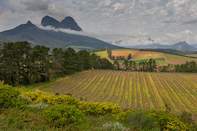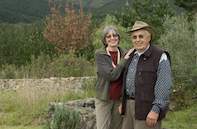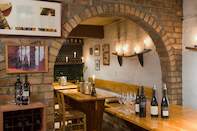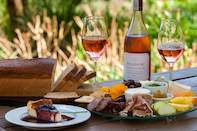Simonsberg

The home of three generations of Sperlings, Delheim situated deep in a Simonsberg kloof is the birthplace of good, old-fashioned Cape winelands hospitality. This is where wine, food and good company have long been enjoyed.
The Sperling Footprint

On 19 April 1951 Michael Sperling, a 20-year-old German of aristocratic descent, disembarked in Table Bay harbour with little more than a suitcase, change from a £10 note and no knowledge of any of the local languages. He had come to the Cape to start a new life on a farm called Driesprong, the home of his mother’s cousin Del and her husband Hans Hoheisen.
More than half a century later, ‘Spatz’ (sparrow) Sperling is was being hailed as a pioneer of the 20th-century Cape wine industry and a driving force behind the first wine route (Stellenbosch), the first public wine auction and now-flourishing local food and wine culture (Delheim’s cheese and charcuterie platter was a first back in the 1970s and remains on offer to this day).
Although ownership of Delheim only devolved to the Sperling family in the first decade of the new millennium, the farm has to all intents and purposes been its home - and passion - ever since the 1950s.
Patriarchal Spatz passed in 2017 but his Dutch-born wife Vera still lives on the farm, with the day-to-day running in the hands of two of their four children: Victor oversees the vineyards and cellar ( supported by winemaker Roelof Lotriet and assistants Nelson Buthelezi and Nongcebo Langa) and Nora Sperling-Thiel manages the team responsible for Delheim’s vibrant marketing, sales and exports.
The close-knit family lives in various homes around the winery, all linked by brick pathways and shaded by massive oak, yellowwood and plane trees. You could bump into any one of them going about their work during the week, probably with a young Sperling and a few Jack Russells in tow.
Cellar Stories

A guided tour of the cellar is recommended for newcomers to wine. While learning about the technicalities of making wine, you’ll hear some entertaining anecdotes about life on this characterful wine farm.
There was a time when young Spatz, overcome by fumes from a tank of fermenting wine, toppled off a ladder. Or when Katy the cow licked up some leaking Pinotage, collapsed in a drunken stupor and, despite all efforts at resuscitation, finally expired.
Or when, in the 1960s, a critical German friend tasted Spatz’s first attempt at a sweet Late Harvest wine and pronounced it ‘Dreck’ (rubbish). The irreverent Spatz coined the name Spatzendreck (sparrow droppings) for the wine.
Delheim’s wines today are anything but ‘Dreck’. They come from the original Driesprong farm’s vineyards behind the winery and from excellent viticultural land just across the R44.
Bought in the 1970s and ‘80s and now amalgamated under the name Delvera, this is the source of some of Delheim’s finest Cabernet Sauvignon, Merlot and Shiraz for the acclaimed Grand Reserve Bordeaux-style blend and single-vineyard Vera Cruz Shiraz, the latter since replaced by the five-star Vera Cruz Pinotage.
The farm’s Chardonnays are particularly good too, notably the barrel-fermented Sur Lie, and dessert wine connoisseurs should try the Natural Sweet and the award-winning Edelspatz Noble Late Harvest.
The farm has traditionally produced wines for a wide range of tastes, including its enduring Pinotage Rosé (formerly off-dry but now classically dry with pleasingly gentle alcohol of just over 12%) and a semi-sweet Gewürztraminer, a variety that is seldom vinified nowadays but recalls the strong German influence on Delheim.
That influence is also seen in the tasting room, a cosy red-brick alcove reminiscent of a Weinstube. The restaurant menu reflects it too, with German specialities such as Bratwurst and Leberwurst alongside traditional South African fare like snoek (fish), springbok and lamb shank.
Conservation Biodiversity Champions

Delheim has long been a member of the SA wine industry’s BWI (Biodiversity & Wine Initiative) and earned championship status in the early 2000s with Victor’s groundbreaking cellar waste-water management scheme that involves a natural water clarification system, including final filtration through an indigenous wetland area.
The Sperlings have also played a role in establishing the Klapmutskop Renosterveld Conservancy, based around Klapmutskop on Delvera.
Three different geological formations meet here and support rare indigenous fynbos vegetation, as well as a centuries-old yellowwood forest recently discovered during a major clearing of alien plants.
 Stellenbosch is arguably the wine capital of South Africa. Winemaking dates back to its settlement in the 17th century and remains the lifeb...
Stellenbosch is arguably the wine capital of South Africa. Winemaking dates back to its settlement in the 17th century and remains the lifeb...